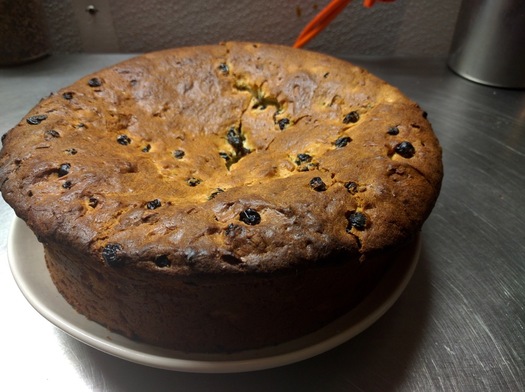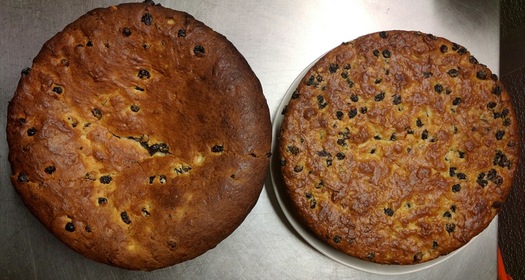Baking that Albany Cake

Same recipe, two different interpretations.
Last week we mentioned that 1828 recipe for "Albany Cake" (thanks, Pamela!), which prompted a a discussion about some of the quirks of the recipe and what the cake might be like.
Well, Greg Kern -- the pastry chef at Peck's Arcade in Troy -- saw the recipe and decided to actually try it.
So we thought it'd be fun to talk with him about how it worked out...
What was your first reaction or expectation when reading through the recipe?
I first noticed the recipe on AOA while I was at work. I stopped what I was doing and read it to my sous chef, Bryan. He has some experience rehashing old recipes.
We both got a kick out of how it was written -- we often refer to my recipes as formulas because they are so precise with both measurements and technique... and this was essentially the polar opposite.
After a few minutes it occurred to me that we keep all of the ingredients in our pantry at Peck's Arcade and it may be kind of fun to play around with -- but because of its fast and loose nature, my expectations were pretty low.
How did you adapt the recipe to make it?
I tried to look at the recipe and figure out what did and did not make sense to me. The big thing, that was pointed out several times in the comments on AOA, was the yeast being measured in "spoonfuls." I assumed that yeast being used in 1828 was probably a far cry from the stuff we use today. My best guess was that it referred to a sourdough -- which I do not keep active. (A few commenters on AOA suggested that it actually referred to yeasty byproducts from brewing). So I thumbed through a few books to find similar recipes written with contemporary ingredients. Once I decided on a yeast measurement I tried to settle on the method. I saw things that I recognized, but nothing was consistent.

The product of following the recipe close to how it's written.
The beginning of the recipe says to combine the flour with butter that has been melted in milk -- this is how you would start pâte à choux (though the ratio of ingredients is a little out of whack). From there you fold in separated egg foams. In pâte à choux, you would emulsify in whole, un-whipped eggs. There is a soufflé method that I was taught that uses a paste very similar to pâte à choux that you fold in whipped egg whites -- but never the whipped yolks. By this point I realized there was no clear direction. I decided that I would just go with the recipe as close to how it is written -- and then at the same time, try making it with the method that makes the most sense to me based on the ingredients and their ratios relative to each other.

The product of using an approach similar to brioche.
The second method I decided to use was most similar to brioche or Berliner beignet or kugelhopf (which often has things like raisins, orange zest, and almonds in it). What I did was take the milk, yeast and flour [and] allow them to ferment for one hour at room temperature. I then added the orange zest, whole eggs, salt*, vanilla*, sugar, and formed a dough. I slowly emulsified the butter into the dough, and finally added the currants and chopped almonds. I allowed the dough to ferment for two hours, then I degassed it and placed it in a 9x3-inch cake ring. Finally, I allowed it to double in volume before baking.
(*I added salt and vanilla to this recipe.)
Thoughts on how it turned out?
The cake that I made using the original method was troublesome from the get go. Folding egg foams into such a dense paste (made with the milk, butter and flour) was doomed from the start. The dough looked fairly broken and took an incredibly long time to rise. It baked surprisingly well and seemed totally fine once it was out of the oven. It colored deeply on the outside -- something I refer to as french brown -- and the crumb and flavor was pretty similar to a muffin or scone. It was entirely bland and unremarkable.

original method
The second cake came together better. The dough never quite emulsified 100 percent, but it was not exactly broken either. I'm guessing it just had too much fat relative to the other ingredients. It rose much faster and looked much more "normal" to me. It colored the same in the oven and came out looking just fine. Its texture was a little more like a yeast-risen dough, similar to a kugelhopf or maybe even Panettone.

brioche method
Visually speaking I preferred the second cake more. Flavor wise... they were pretty identical. Just kind of bland, boring, unremarkable.
I left them up for grabs at the pastry station at Peck's and by the end of service both cakes were about half eaten. This may be an indicator that I am more critical of pastries than other people.

You mentioned referencing some older Dutch cookbooks that you have and noticing similarities. Anything specific that seems particularly "Dutch" about it?
I wont pretend to be an authority on Dutch anything -- but what I found funny was that virtually every Dutch cake I came across in my limited search was a dough enriched with egg and butter and milk and they all seemed to have currants, almonds, and citrus. The differences were mostly in the ingredients quantity, the method, and how they were cooked/baked.
My personal favorite was called Jan in de Zak -- which had all the same ingredients -- but the dough was wrapped in a towel and boiled!
As a modern pastry chef, is there anything that you draw -- whether it's context, or inspiration, or whatever -- from going through an old recipe like this one?
There is a certain spark that comes from it. If not for this recipe, I would likely never have never come across Jan in de Zak, which I am in complete awe over.
With modern recipes you pretty much see minor variations on the same thing, over and over and over. It's refreshing finding things that are so bizarre, so contradictory to what I know and understand. I have quite a few things in my "bag of tricks" that have come from playing around like this.
I primarily do plated desserts -- and when you break them down, they are just different combinations of tastes and textures. While this particular cake won't make the cut -- let's say it had and further down the road I wanted to make a dessert highlighting currants or one that used a yeasted dough -- then I would remember this cake and the conceptualization of a new dessert would begin.
This interview was conducted via email and has been lightly edited.
Greg Kern is the executive pastry chef for Peck's Arcade, The Lucas Confectionery, and the upcoming Little Peck's. He writes about food and his work at his blog, Humbling Attempts.
photos: Greg Kern
Hi there. Comments have been closed for this item. Still have something to say? Contact us.
Comments
When I read the article last week I was thinking that most of the meals in the online recipe book that Mr. Rittner posted could potentially be on the menu at Peck's.
... said Cyril on Nov 23, 2015 at 1:54 PM | link
He must have nailed the recipe since the flavor embodies much of what Albany is: kind of bland, boring, and unremarkable.
lol ;-)
... said ace on Nov 23, 2015 at 2:35 PM | link
My Catskill Dutch grandmother had a warm lemon sauce (made with fresh squeezed lemons and their zest) that she would have drizzled over that cake as it was served.
... said chezjake on Nov 23, 2015 at 8:23 PM | link
Thanks to Pecks for experimenting with the recipe and to AOA for writing about it! When I read it, I wanted to try it myself but was left bewildered by the yeast measurements. I was hoping Peck's would share their specific yeast findings (aka- what type of yeast and how much) but by the time I finished reading the article, and how bland the chef thought the cake was, I think I'll forgo trying this one at home.
... said Cori on Nov 24, 2015 at 1:45 PM | link
What Ace said
... said Marco Romano on Apr 6, 2017 at 9:10 AM | link